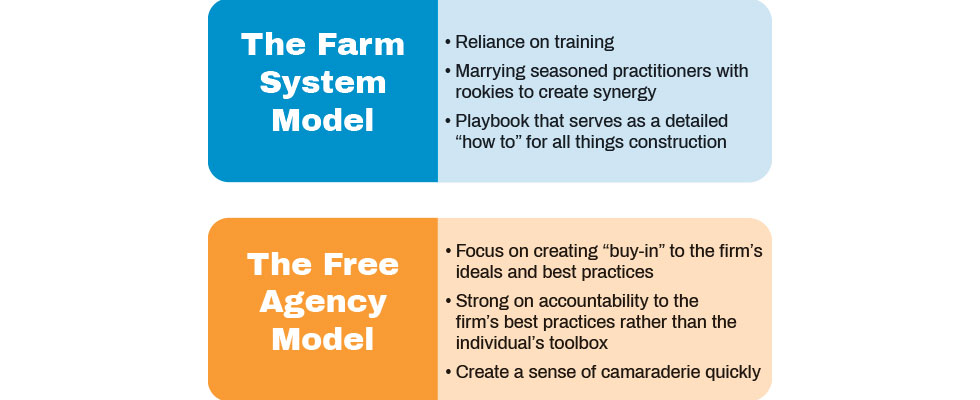
Even when the game isn’t on, the world of sports keeps pressing. In the dead of winter, baseball teams are doling out large sums of money to get the best free agents in the market. Before the last second of the Super Bowl, general managers and coaches are feverishly examining a fresh crop of college recruits entering the draft. Both baseball and football have drafts, and both have the opportunity to enhance its team’s talent through free agency.
Standout teams like the New York Yankees seem to have an endless stream of cash to pay for the best players that other teams have developed in their farm systems. On the other hand, how many wide receivers did the Detroit Lions draft in the early 2000s?
There is not the same clamor of recruiting in the world of construction. Imagine the fanfare as Brand X Construction makes its eighth selection for an equipment operator and their tenth selection for a project engineer. While there is no draft per se, construction firms annually select from a bright group of men and women in high schools, trade schools and universities.
Additionally, there is no moratorium on free agency, as professionals regularly traverse the construction landscape seeking new opportunities. All that said, firms need to understand how their strategy aligns with their talent goals. For instance, recruiting new talent from universities may be a sound philosophy for some firms, but without the right strategy to support it, the new professionals will only flounder.
In the end, every firm will engage in both talent pools—the farm system and free agency—but the ones that make a conscious decision and back it up with the right tactics will win the never-ending war for talent.

A Case for the Farm System
Whether it’s the wide-eyed new graduate from a local college or the greenhorn apprentice from a trade school, both hopefully come into a new firm with a lot of ambition and little to no experience. Schooling provides essential skills, but there is almost no equivalent to seeing construction in real time.
The flaw in many firms is that they recruit from these sources and then thrust those individuals into a world with little to no training. How often have we heard, “We let them sink or swim,” or, “We throw them to the wolves.” Why are we throwing anyone anywhere? Yes, real-world experience is imperative and there are few substitutes for it, but there are alternative methods and means for accomplishing this all while setting new team members up for success.
The first is a development plan that aligns with the operational model of the firm. Even if a new manager learned about change orders and requests for information, there should be an indoctrination with the firm’s model. Constructing a project schedule in software is one thing, but building a schedule in concert with a seasoned superintendent is another story. Firms that rely on rookie talent must have a playbook that clearly articulates how to build in accordance with the firm.
Too often, new associates are handed a manual for standard operating procedures on day one and that might be the last time it is opened, unless they are looking for a vacation request. This playbook needs to be the guide for everything anyone would need to do—or know how to do—in the firm, regardless of tenure.
Secondly, there should be a robust training program that focuses on practical knowledge for all associates. The operative word here is “all.” What better way to reinforce the “how to” than to have senior and junior associates mingle together? Additionally, even the saltiest of veterans need to be reminded of the firm’s best practices from time to time.
The farm system approach does not mean the firm avoids free agents. However, creating homegrown talent focuses on molding a cadre of associates that learn the firm’s way of building from day one since there are no other behaviors that have not yet taken root.
A Case for Free Agency
Whether it’s because a firm always seems to have a bountiful backlog or the talent pool in their market is weak, bringing in free agents often seems to be the most viable source of talent.
Free agents have already been trained, and in some cases, they bring a strong book of business they’ve developed with them. They bring their own toolkit and a Rolodex from their years in the industry. However, it is important to note that they also bring in their own toolkit and behaviors from their years in the business. Did we mention that already?
For every sports superstar and team player that braved the free agency market, there are countless stories of the teammate who was a cancer to the team and had a detrimental effect on the overall business. The same can be said for a construction organization.
Without a codified set of best practices and, most importantly, a strict methodology for accountability, free agents can run amok and leave a wake of destruction in their path—both internally and externally.
Training this group is less about the construction methods and means and more about the firm’s culture and behavioral model. Free agents have worn a few jerseys in their time in the field. It is important to make sure the current jersey is the right fit and creates a sense of belonging and passion. Whether it is how customers should be treated or why a process is integral to the firm’s success, free agents need to see the connective tissue to ensure buy-in.
Accountability is critical. The scoreboard doesn’t change because a new player arrives on the field. In the end, talented managers and superintendents need to play within the confines of the model leadership has created.
While there needs to be an openness to new ideas and avoidance of the status quo, the firm has to protect against multiple versions of the playbook simply because a manager “did it this way” at their last job.
It can seem serendipitous when looking at talent acquisition. Every construction firm would love a steady stream of qualified applicants exactly when and where they need them. The reality is much different, and will vary considerably based on market conditions, geography, sources of talent and more.
However, a firm can make the conscious decision about how it wants to strategically position itself as a magnet for talent, whether that talent is a rookie or a seasoned veteran. Now, should we talk about signing bonuses?
